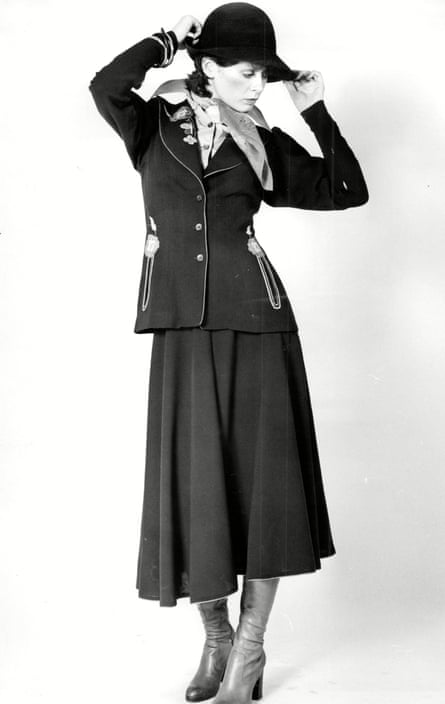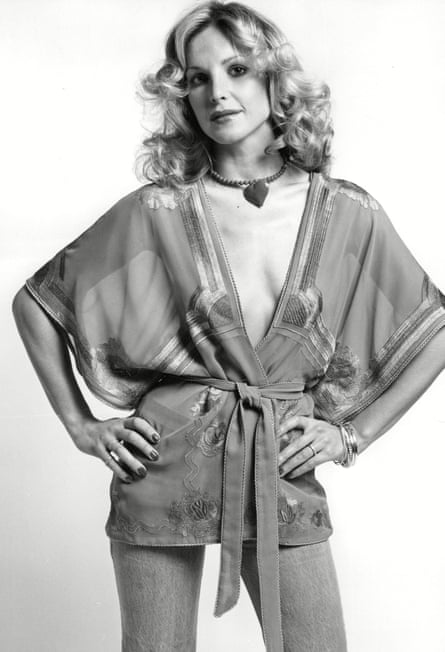
“I like each garment to be a nice object,” said Janice Wainwright, early in her career as the designer of a quiet, durably successful, fashion label. She shared with other young British designers of the late 1960s and 70s a taste for clothes that were near-craftworks, which pleased the eye just hung on a rail, and satisfied even inside out because of thoughtful construction and finish. Hers photographed well, but lived better, especially her discreet not-quite-suits in crepe with artwork details, which are now collected to be worn rather than as period pieces.
Wainwright, who has died aged 82, had a vocation for the clothes themselves and the processes of their making. At 20, she had won a place on Janey Ironside’s revolutionary course at the Royal College of Art in London. Before becoming professor of fashion, Ironside had been a skilled, imaginative dressmaker, and she taught students (including Ossie Clark, Bill Gibb and Zandra Rhodes) that fashion should be more than a transient look transmitted through images: clothes could be physical pleasures, and should serve their wearer’s identity, not subsume it.
Ironside demanded that her proteges be grounded in the grinding business of production, too, and Wainwright took that task on early. While still at the RCA she was permitted to design part-time for a mass-manufacture firm, Simon Massey, which was widening its customers from those who bought inexpensive much-blurred Paris copies to the young, who wanted an affordable version of wacky boutique designers.
After graduation, Wainwright was given her own “designed by” label inside Massey garments within a year, and worked for the firm through the 60s. The job was an education in compromise – if she produced an original textile design it often had to be printed on unsuitable cheap fabric to keep within budget, and she had to deal with factories (all in the UK) to ensure they would machine enough quantity to an adequate standard by deadline.
The experience paid off when she began to work independently from 1972, and, having bought out her founding investors, with her own company from 1974, named Forty Seven Poland Street after its Soho address. No more Banlon: Wainwright could afford quality raw materials – Bernard Nevill’s figured velvets, Celia Birtwell’s graphic chiffons, silk woven to order in Lyon or printed to imitate vintage samples she found in California.
Wainwright knew which factories could handle dressmaker-level finishes, roll chiffon edges or top-stitch crepe, since her concept for her label lay between the detailing of one-off creations (with appliques and embroidery done by specialists) and semi-volume manufacture. Her evening wear had an appeal much like the then-admired vintage art deco pieces – it had a Roxy Music retro glamour, subtler than glitz.
Despite the steep prices that resulted from first-class fabric and time-consuming details, Wainwright was soon exporting 60% of her output, proud to have sales among the picky stylish of France and Japan; as well as grand US department store buyers, including Bergdorf Goodman and Neiman Marcus, she had a concession in Harvey Nichols, and was a regular label in Harrods and Selfridges.

Although a loyal customer might be favoured with a bespoke wedding dress, Wainwright had no interest in celebrity, either clients’ or her own. Her core firm stayed small, around 20 people, including her sister, Wendy, as head of marketing, plus, in the 80s, Horace the computer to deal with stock control. They made limited concessions to the industry changes that brought in heightened publicity and advertising, offshore production, and a sharpened division between high-profile couture and high-volume but very short-lived mass fashion (the young of the 60s had bought fewer items and worn them more often).
Wainwright retired in 1990, though continued to lecture to students, as she had since leaving college. She acknowledged her debt to education: her parents, Joseph and Irene (nee Lowe), had left school at 14, later finding security in civil service jobs in the Ministry of Defence. She was born in Doe Lea, Derbyshire, and grew up in what she recalled as a succession of ever-bigger council houses in Wimbledon, south-west London, and went to the Willows school in nearby Morden.
She chose to channel her talent for art towards fashion, as a possible employment path for a woman, beginning with Saturday morning drawing classes. At 15, she went to Wimbledon School of Art, then Kingston School of Art, then the RCA, where she proved the kind of scholarship winner Ironside believed in.
Wainwright married in 1968 David Cripps, who had trained as a graphic designer but became a great still-life photographer, especially of crafted objects; they had a son, Aaron, and divorced in 1973.
After retirement, Wainwright moved to Sydney, Australia, where she re-encountered the architect and artist Rollin Schlict, whom she had met in his bohemian youth in 60s London. They married in 2003; he died in 2011, and she returned to the UK in 2017.
She is survived by Aaron and her grandchildren, Daisy and Ned.



